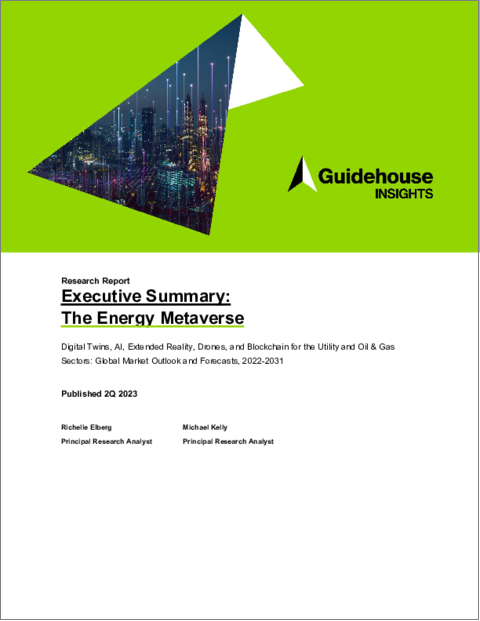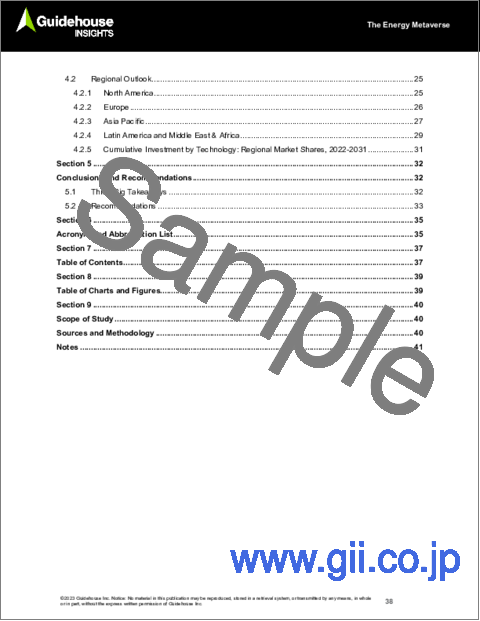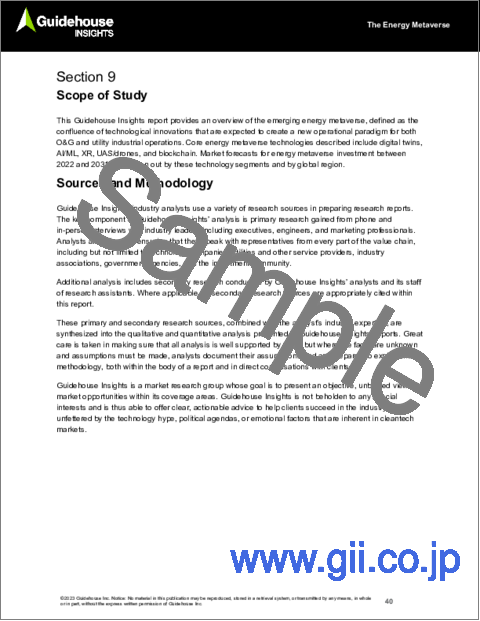|
|
市場調査レポート
商品コード
1300003
エネルギーメタバースThe Energy Metaverse - Digital Twins, AI, Extended Reality, Drones, and Blockchain for the Utility and Oil & Gas Sectors: Global Market Outlook and Forecasts, 2022-2031 |
||||||
|
|||||||
| エネルギーメタバース |
|
出版日: 2023年06月30日
発行: Guidehouse Research
ページ情報: 英文 42 Pages; 33 Tables, Charts & Figures
納期: 即納可能
|
- 全表示
- 概要
- 図表
- 目次
今後10年間のエネルギー産業におけるメタバース中核技術への累積投資額は3,000億米ドルを超えると予測されています。
当レポートでは、エネルギー産業におけるメタバースの市場を調査し、コア技術の定義、ケーススタディ、市場促進要因および障壁、産業バリューチェーン、競合情勢、ユーティリティ産業および石油・ガスエネルギー産業におけるメタバースの中核技術への投資予測などをまとめています。
目次
第1章 エグゼクティブサマリー
- エネルギーメタバース:市場予測
第2章 市場における課題
- メタバースとは何か
- メタバース技術
- デジタルツイン
- AI・機械学習
- 拡張現実
- 無人航空機システムとドローン
- メタノミクス・ブロックチェーン
- 市場促進要因
- 市場の障壁
- エネルギー産業のメタバースロードマップ
- エネルギー産業のメタバースと持続可能性
第3章 産業のバリューチェーン
- 競合情勢
- 大手エネルギーIT/OTソリューションプロバイダー
- XR機器およびソフトウェアプロバイダー
- UAS/ドローン機器およびソフトウェアプロバイダー
- メタバースプラットフォームプロバイダー
第4章 市場予測
- 調査手法
- 地域別の展望
- 北米
- 欧州
- アジア太平洋
- ラテンアメリカ・中東・アフリカ
- 技術別の累積投資:地域市場シェア
第5章 総論・提言
- 3つの大きなポイント
- 提言
第6章 頭字語・略語のリスト
第7章 目次
第8章 図表
第9章 調査範囲・情報源・調査手法・注記
List of Tables
- Energy Metaverse Spending by Region, World Markets: 2022-2031
- Energy Metaverse Spending by Technology Segment, World Markets: 2022-2031
- Energy Metaverse Spending by Technology Segment, North America: 2022-2031
- Energy Metaverse Spending by Technology Segment, Europe: 2022-2031
- Energy Metaverse Spending by Technology Segment, Asia Pacific: 2022-2031
- Energy Metaverse Spending by Technology Segment, Latin America: 2022-2031
- Energy Metaverse Spending by Technology Segment, Middle East & Africa: 2022-2031
- Energy Metaverse Spending by Region, Digital Twins: 2022-2031
- Energy Metaverse Spending by Region, AI/ML: 2022-2031
- Energy Metaverse Spending by Region, Extended Reality: 2022-2031
- Energy Metaverse Spending by Region, UAS/Drones: 2022-2031
- Energy Metaverse Spending by Region, Blockchain: 2022-2031
List of Figures
- Energy Metaverse Spending by Region, World Markets: 2022-2031
- Energy Metaverse Spending by Technology Segment, World Markets: 2022-2031
- Energy Metaverse Spending by Technology Segment, North America: 2022-2031
- Energy Metaverse Spending by Technology Segment, Europe: 2022-2031
- Energy Metaverse Spending by Technology Segment, Asia Pacific: 2022-2031
- Energy Metaverse Spending by Technology Segment, Latin America: 2022-2031
- Energy Metaverse Spending by Technology Segment, Middle East & Africa: 2022-2031
- Cumulative Energy Metaverse Spending Share by Region, World Markets: 2022-2031
- Cumulative Energy Digital Twin Spending Share by Region, World Markets: 2022-2031
- Cumulative Energy AI/ML Spending Share by Region, World Markets: 2022-2031
- Cumulative Energy Extended Reality Spending Share by Region, World Markets: 2022-2031
- Cumulative Energy UAS/Drones Spending Share by Region, World Markets: 2022-2031
- Cumulative Energy Blockchain Spending Share by Region, World Markets: 2022-2031
Core Components of the Energy Metaverse
Digital Twin Maturity Dimensions
The Digital Twin Hierarchy (Utility Example)
The Extended Reality Spectrum
Blockchain Use Cases across the Energy and Power Industries
Energy Metaverse Technologies and Use Cases
Typical Activities and Progress across the Energy Metaverse Value Chain
Select Energy Metaverse Solution Vendors
The energy metaverse is just emerging, but the building blocks are securely in place-so much so that Guidehouse Insights forecasts more than $300 billion in cumulative global investment in core energy metaverse technologies over the next decade. So just what is the energy metaverse?
Broadly speaking, the metaverse is the confluence of several emerging digital technologies, most already familiar to energy industry executives, which promises to radically change the way energy companies plan, build, operate, and market their services over the long term. Core energy metaverse technologies include digital twins, AI and machine learning (ML), unmanned aerial systems (UAS) and drones, extended reality (XR), and blockchain-based applications.
When the energy metaverse is fully realized-admittedly more than a decade away-utilities and oil & gas (O&G) concerns can envision a day when employee onboarding and training take place via XR in a metaverse-based training center. Utility storefronts in metaverse malls could provide virtual customers with real-world benefits such as product comparisons and purchasing, energy use analysis, and evaluation of a premises' suitability for solar. In-demand specialized experts in a field could work on a virtual offshore rig, advising onsite workers how to address a problem-without ever leaving their home office. And drones could conduct ongoing inspections of critical assets, feeding real-time data into digital twins equipped with advanced AI to predict and prevent wildfires or methane emissions.
This Guidehouse Insights report provides an overview of the energy metaverse. It defines the core technologies and provides case studies where these technologies are in use today. It outlines energy metaverse market drivers and barriers and describes the industry value chain and competitive landscape. Finally, it provides market forecasts for core energy metaverse technology investments by the utility and O&G energy verticals through 2031.
Table of Contents
1. Executive Summary
- 1.1 Energy Metaverse Market Forecast
2. Market Issues
- 2.1 What Is the Metaverse?
- 2.2 Metaverse Technologies
- 2.2.1 Digital Twins.
- 2.2.1.1 Case Study: Transmission System Operator
- 2.2.1.2 Case Study: Oil Refinery
- 2.2.2 AI and Machine Learning
- 2.2.3 Extended Reality
- 2.2.3.1 Case Study: American Electric Power
- 2.2.4 Unmanned Aerial Systems and Drones
- 2.2.5 Metanomics and Blockchain
- 2.2.5.1 Energy Metanomics and Blockchain
- 2.2.1 Digital Twins.
- 2.3 Market Drivers
- 2.4 Market Barriers
- 2.5 A Metaverse Roadmap for the Energy Industry
- 2.6 The Energy Metaverse and Sustainability
3. Industry Value Chain
- 3.1 Competitive Landscape
- 3.1.1 Major Energy IT/OT Solution Providers
- 3.1.2 XR Equipment and Software Providers
- 3.1.3 UAS/Drone Equipment and Software Providers
- 3.1.4 Metaverse Platform Providers
- 3.1.4.1 NVIDIA Omniverse Case Study: Predictive Maintenance in Power Plants
4. Market Forecasts
- 4.1 Methodology
- 4.2 Regional Outlook
- 4.2.1 North America
- 4.2.2 Europe
- 4.2.3 Asia Pacific
- 4.2.4 Latin America and Middle East & Africa
- 4.2.5 Cumulative Investment by Technology: Regional Market Shares, 2022-2031
5. Conclusions and Recommendations
- 5.1 Three Big Takeaways
- 5.2 Recommendations





